MICROSCOPE-ANTIQUES.COM © 2013-15.
SHORT TRIPOD MICROSCOPES OF THE NINETEENTH AND FIRST THIRD OF THE TWENTIETH CENTURY.
MODELS:
'Screw-Adjusting Tripod Microscope on Three Brass Feet' (McAllister, 1855)
'Tripod Dissecting Microscope' OR
'Seed Microscope on three feet'(W.Y. McAllister, 1867), OR
'Three-legged Microscope'(Beck 1882)
BRASS VERSIONS: c. 1850-1920
PAINTED BLACK VERSIONS: c. 1920-1940

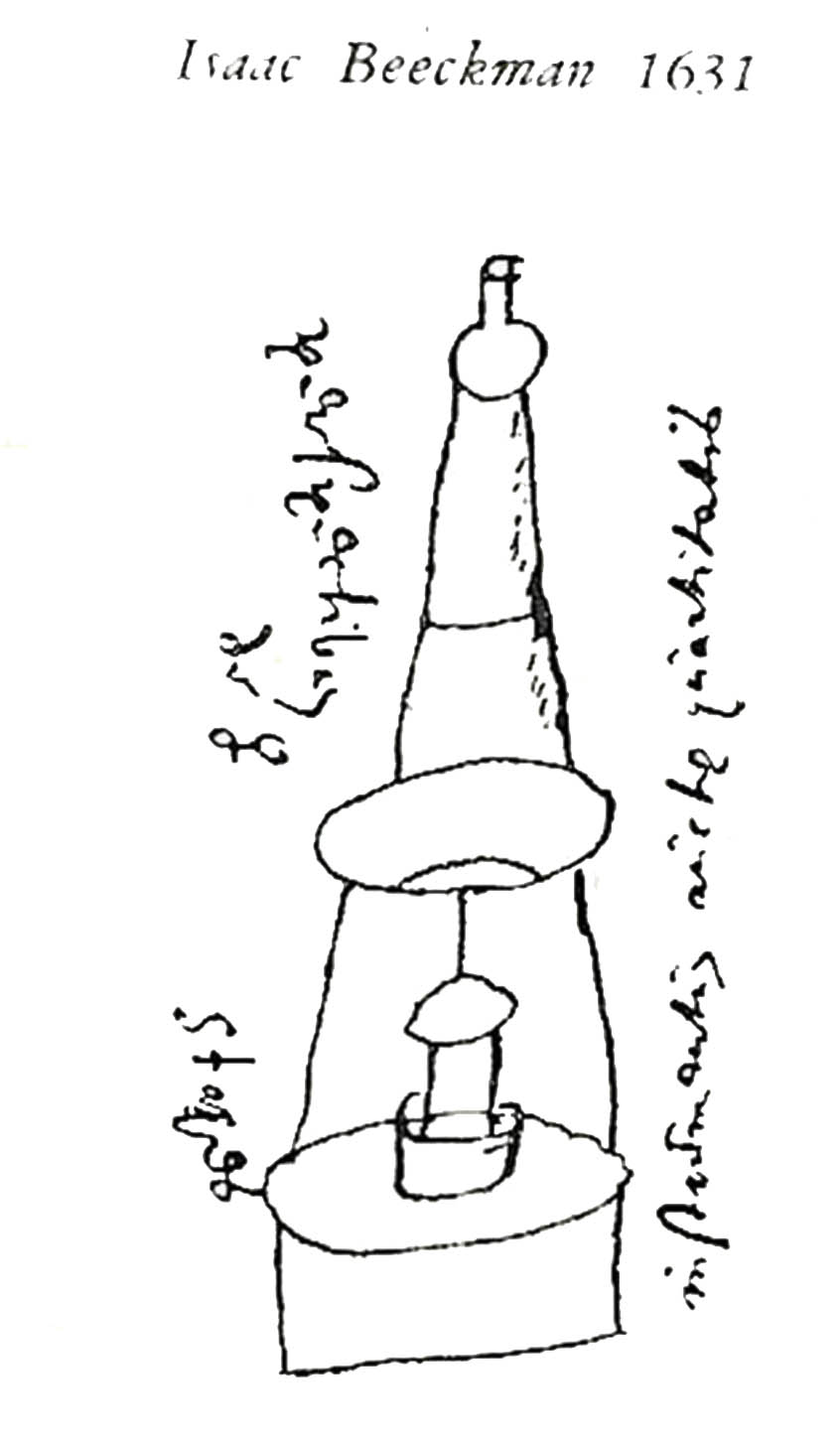 The first known illustration of a 'microscope', by Isaac Beekman in 1631, was of a compound microscope mounted on a tripod. Tripod microscopes of various types continued to be made intermittently from that time, clear through the twentieth century. Although there were many compound tripod models, perhaps the most common is the type shown on this page which is a simple microscope. These simple microscopes were used as magnifiers for relatively low power work such as dissection, viewing seeds, etc. An early to mid 20th century variation, a bit taller than the others, and made of black painted metal, was marketed by the Testrite Company as a 'Fingerprint Tripod Magnifier', though inferior to other types made for that purpose.
The first known illustration of a 'microscope', by Isaac Beekman in 1631, was of a compound microscope mounted on a tripod. Tripod microscopes of various types continued to be made intermittently from that time, clear through the twentieth century. Although there were many compound tripod models, perhaps the most common is the type shown on this page which is a simple microscope. These simple microscopes were used as magnifiers for relatively low power work such as dissection, viewing seeds, etc. An early to mid 20th century variation, a bit taller than the others, and made of black painted metal, was marketed by the Testrite Company as a 'Fingerprint Tripod Magnifier', though inferior to other types made for that purpose.
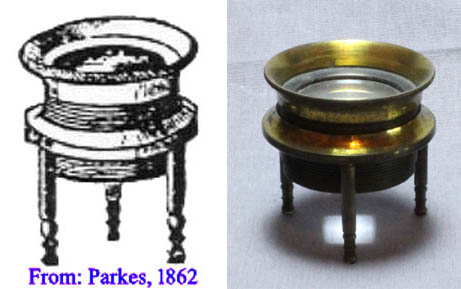
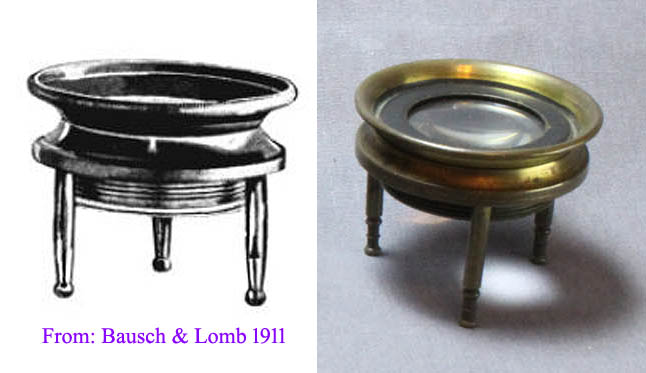 The original lacquered brass versions were sold from the middle of the ninteenth century, starting no later than 1855, right up until the beginning of the second quarter of the twentieth century. The earlier versions(left, c. 1855-1880s) had a wider upturned brim over the lens. Starting in the last quarter of the 19th centurry, brass versions have a flatter profile(right). After that, those made of black-painted metal were more common. The earliest catalog entry I have found so far is from a McAllister & Brothers catalog from 1855. Subsequently they can be found illustrated in Parkes' catalog of 1862, in Beck's catalog of 1882 and likely many others I have not examined. In the 1880's Beck offered their 'Three-legged Microscope' with a choice of a brass support, rubber support, or steel support, brass being the cheapest and steel the most expensive. Bausch & Lomb catalogs as late as 1911 show it in lacquered brass; by 1922 it was shown with a slightly different design made of black painted metal. It was also advertised by Wollensak as late as 1939.
The original lacquered brass versions were sold from the middle of the ninteenth century, starting no later than 1855, right up until the beginning of the second quarter of the twentieth century. The earlier versions(left, c. 1855-1880s) had a wider upturned brim over the lens. Starting in the last quarter of the 19th centurry, brass versions have a flatter profile(right). After that, those made of black-painted metal were more common. The earliest catalog entry I have found so far is from a McAllister & Brothers catalog from 1855. Subsequently they can be found illustrated in Parkes' catalog of 1862, in Beck's catalog of 1882 and likely many others I have not examined. In the 1880's Beck offered their 'Three-legged Microscope' with a choice of a brass support, rubber support, or steel support, brass being the cheapest and steel the most expensive. Bausch & Lomb catalogs as late as 1911 show it in lacquered brass; by 1922 it was shown with a slightly different design made of black painted metal. It was also advertised by Wollensak as late as 1939.
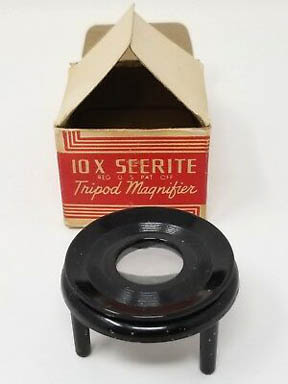 The short tripod magnifier was also marketed with a Bakelite lens housing as the 'Seerite' model by the Testrite company probably in the 1930's. Other examples of the same instrument with a Bakelite lens housing were sold under various other brand names such as the 'Compass' brand. Many surviving examples of these magnifiers have cracked lens housings, as Bakelite, a durable but relatively brittle material, is easily broken if e.g. dropped. As mentioned above, the Testrite company also sold a larger metal and Bakelite version as a fingerprint magnifier sometime after 1940. Interestingly, the Testrite company is still in business but now specializes in visual display and merchandising materials.
The short tripod magnifier was also marketed with a Bakelite lens housing as the 'Seerite' model by the Testrite company probably in the 1930's. Other examples of the same instrument with a Bakelite lens housing were sold under various other brand names such as the 'Compass' brand. Many surviving examples of these magnifiers have cracked lens housings, as Bakelite, a durable but relatively brittle material, is easily broken if e.g. dropped. As mentioned above, the Testrite company also sold a larger metal and Bakelite version as a fingerprint magnifier sometime after 1940. Interestingly, the Testrite company is still in business but now specializes in visual display and merchandising materials.
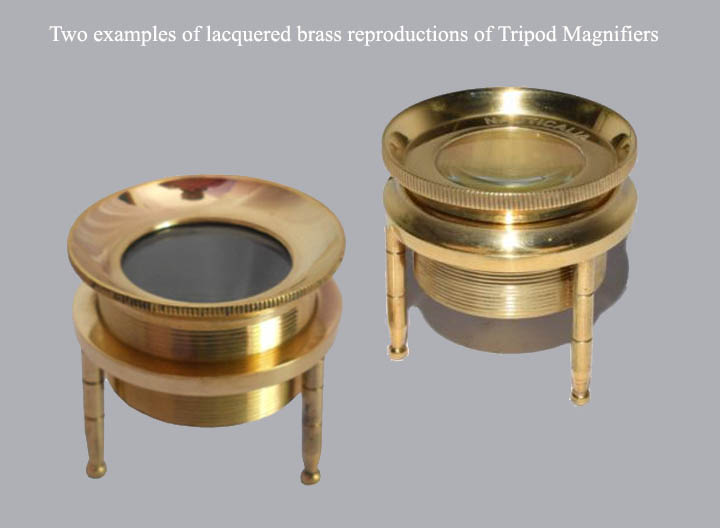
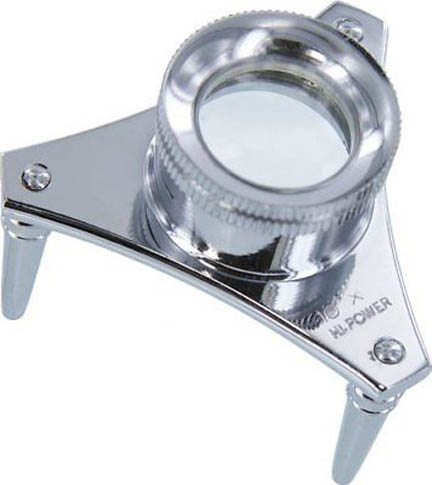 The ubiquitous lacquered brass tripod microscopes of the 19th century are still extremely common on the antique market. Reproductions are also commonly sold as potential gifts. Lacquered brass reproductions(left) commonly sell on Ebay for as little as $14 to as much as about $100 with either a bright lacquered finish(left) or a duller 'antique' finish. Of some note, a genuine antique magnifier of this type usually sells for between about $25 and $150, depending on condition and if with original case. Today, in addition to new reproductions, modern versions of these, often chrome-plated, and with triangular support for the legs(right), are still being made new in the 21st century.
The ubiquitous lacquered brass tripod microscopes of the 19th century are still extremely common on the antique market. Reproductions are also commonly sold as potential gifts. Lacquered brass reproductions(left) commonly sell on Ebay for as little as $14 to as much as about $100 with either a bright lacquered finish(left) or a duller 'antique' finish. Of some note, a genuine antique magnifier of this type usually sells for between about $25 and $150, depending on condition and if with original case. Today, in addition to new reproductions, modern versions of these, often chrome-plated, and with triangular support for the legs(right), are still being made new in the 21st century.

 The first known illustration of a 'microscope', by Isaac Beekman in 1631, was of a compound microscope mounted on a tripod. Tripod microscopes of various types continued to be made intermittently from that time, clear through the twentieth century. Although there were many compound tripod models, perhaps the most common is the type shown on this page which is a simple microscope. These simple microscopes were used as magnifiers for relatively low power work such as dissection, viewing seeds, etc. An early to mid 20th century variation, a bit taller than the others, and made of black painted metal, was marketed by the Testrite Company as a 'Fingerprint Tripod Magnifier', though inferior to other types made for that purpose.
The first known illustration of a 'microscope', by Isaac Beekman in 1631, was of a compound microscope mounted on a tripod. Tripod microscopes of various types continued to be made intermittently from that time, clear through the twentieth century. Although there were many compound tripod models, perhaps the most common is the type shown on this page which is a simple microscope. These simple microscopes were used as magnifiers for relatively low power work such as dissection, viewing seeds, etc. An early to mid 20th century variation, a bit taller than the others, and made of black painted metal, was marketed by the Testrite Company as a 'Fingerprint Tripod Magnifier', though inferior to other types made for that purpose.

 The original lacquered brass versions were sold from the middle of the ninteenth century, starting no later than 1855, right up until the beginning of the second quarter of the twentieth century. The earlier versions(left, c. 1855-1880s) had a wider upturned brim over the lens. Starting in the last quarter of the 19th centurry, brass versions have a flatter profile(right). After that, those made of black-painted metal were more common. The earliest catalog entry I have found so far is from a McAllister & Brothers catalog from 1855. Subsequently they can be found illustrated in Parkes' catalog of 1862, in Beck's catalog of 1882 and likely many others I have not examined. In the 1880's Beck offered their 'Three-legged Microscope' with a choice of a brass support, rubber support, or steel support, brass being the cheapest and steel the most expensive. Bausch & Lomb catalogs as late as 1911 show it in lacquered brass; by 1922 it was shown with a slightly different design made of black painted metal. It was also advertised by Wollensak as late as 1939.
The original lacquered brass versions were sold from the middle of the ninteenth century, starting no later than 1855, right up until the beginning of the second quarter of the twentieth century. The earlier versions(left, c. 1855-1880s) had a wider upturned brim over the lens. Starting in the last quarter of the 19th centurry, brass versions have a flatter profile(right). After that, those made of black-painted metal were more common. The earliest catalog entry I have found so far is from a McAllister & Brothers catalog from 1855. Subsequently they can be found illustrated in Parkes' catalog of 1862, in Beck's catalog of 1882 and likely many others I have not examined. In the 1880's Beck offered their 'Three-legged Microscope' with a choice of a brass support, rubber support, or steel support, brass being the cheapest and steel the most expensive. Bausch & Lomb catalogs as late as 1911 show it in lacquered brass; by 1922 it was shown with a slightly different design made of black painted metal. It was also advertised by Wollensak as late as 1939.  The short tripod magnifier was also marketed with a Bakelite lens housing as the 'Seerite' model by the Testrite company probably in the 1930's. Other examples of the same instrument with a Bakelite lens housing were sold under various other brand names such as the 'Compass' brand. Many surviving examples of these magnifiers have cracked lens housings, as Bakelite, a durable but relatively brittle material, is easily broken if e.g. dropped. As mentioned above, the Testrite company also sold a larger metal and Bakelite version as a fingerprint magnifier sometime after 1940. Interestingly, the Testrite company is still in business but now specializes in visual display and merchandising materials.
The short tripod magnifier was also marketed with a Bakelite lens housing as the 'Seerite' model by the Testrite company probably in the 1930's. Other examples of the same instrument with a Bakelite lens housing were sold under various other brand names such as the 'Compass' brand. Many surviving examples of these magnifiers have cracked lens housings, as Bakelite, a durable but relatively brittle material, is easily broken if e.g. dropped. As mentioned above, the Testrite company also sold a larger metal and Bakelite version as a fingerprint magnifier sometime after 1940. Interestingly, the Testrite company is still in business but now specializes in visual display and merchandising materials.

 The ubiquitous lacquered brass tripod microscopes of the 19th century are still extremely common on the antique market. Reproductions are also commonly sold as potential gifts. Lacquered brass reproductions(left) commonly sell on Ebay for as little as $14 to as much as about $100 with either a bright lacquered finish(left) or a duller 'antique' finish. Of some note, a genuine antique magnifier of this type usually sells for between about $25 and $150, depending on condition and if with original case. Today, in addition to new reproductions, modern versions of these, often chrome-plated, and with triangular support for the legs(right), are still being made new in the 21st century.
The ubiquitous lacquered brass tripod microscopes of the 19th century are still extremely common on the antique market. Reproductions are also commonly sold as potential gifts. Lacquered brass reproductions(left) commonly sell on Ebay for as little as $14 to as much as about $100 with either a bright lacquered finish(left) or a duller 'antique' finish. Of some note, a genuine antique magnifier of this type usually sells for between about $25 and $150, depending on condition and if with original case. Today, in addition to new reproductions, modern versions of these, often chrome-plated, and with triangular support for the legs(right), are still being made new in the 21st century.